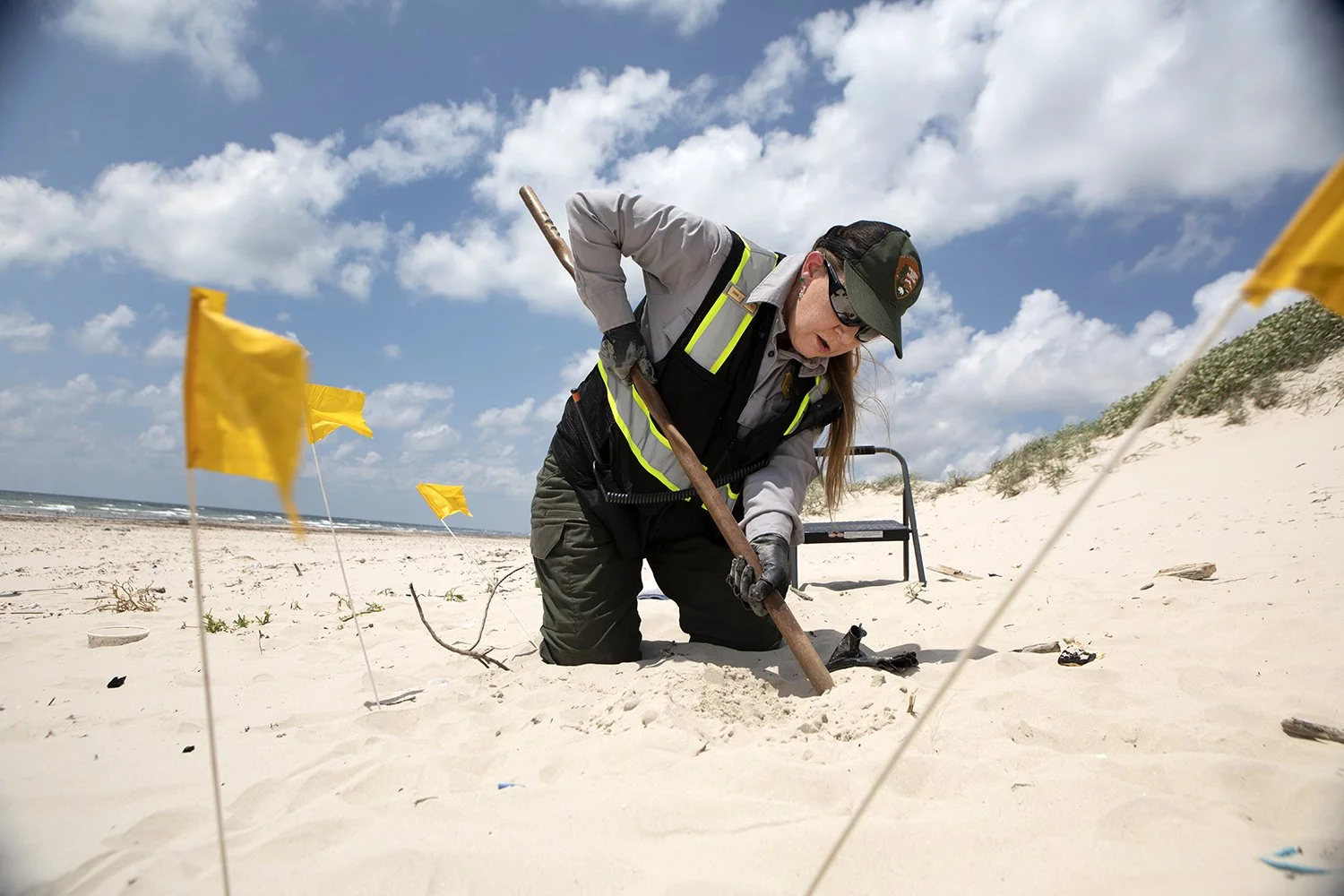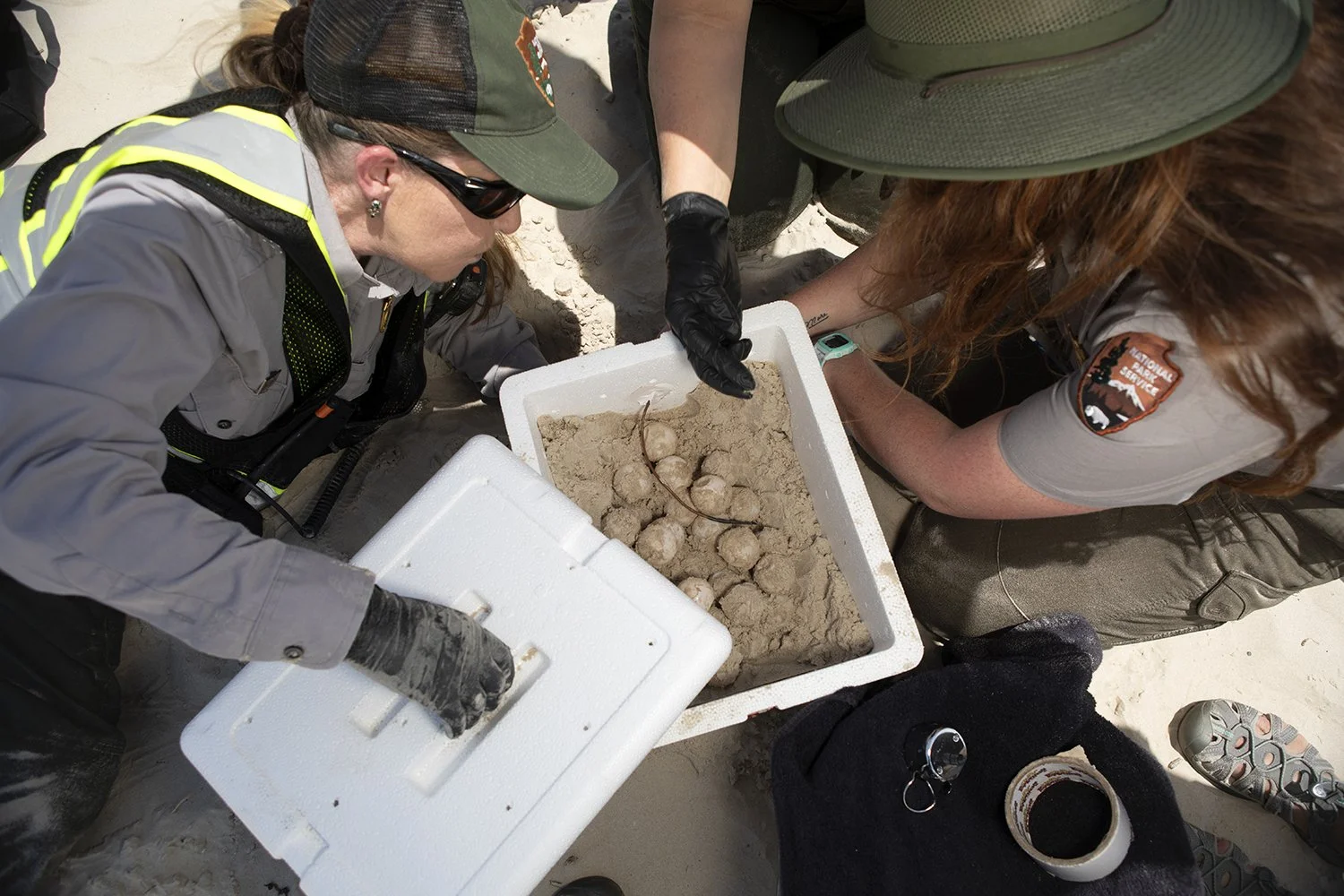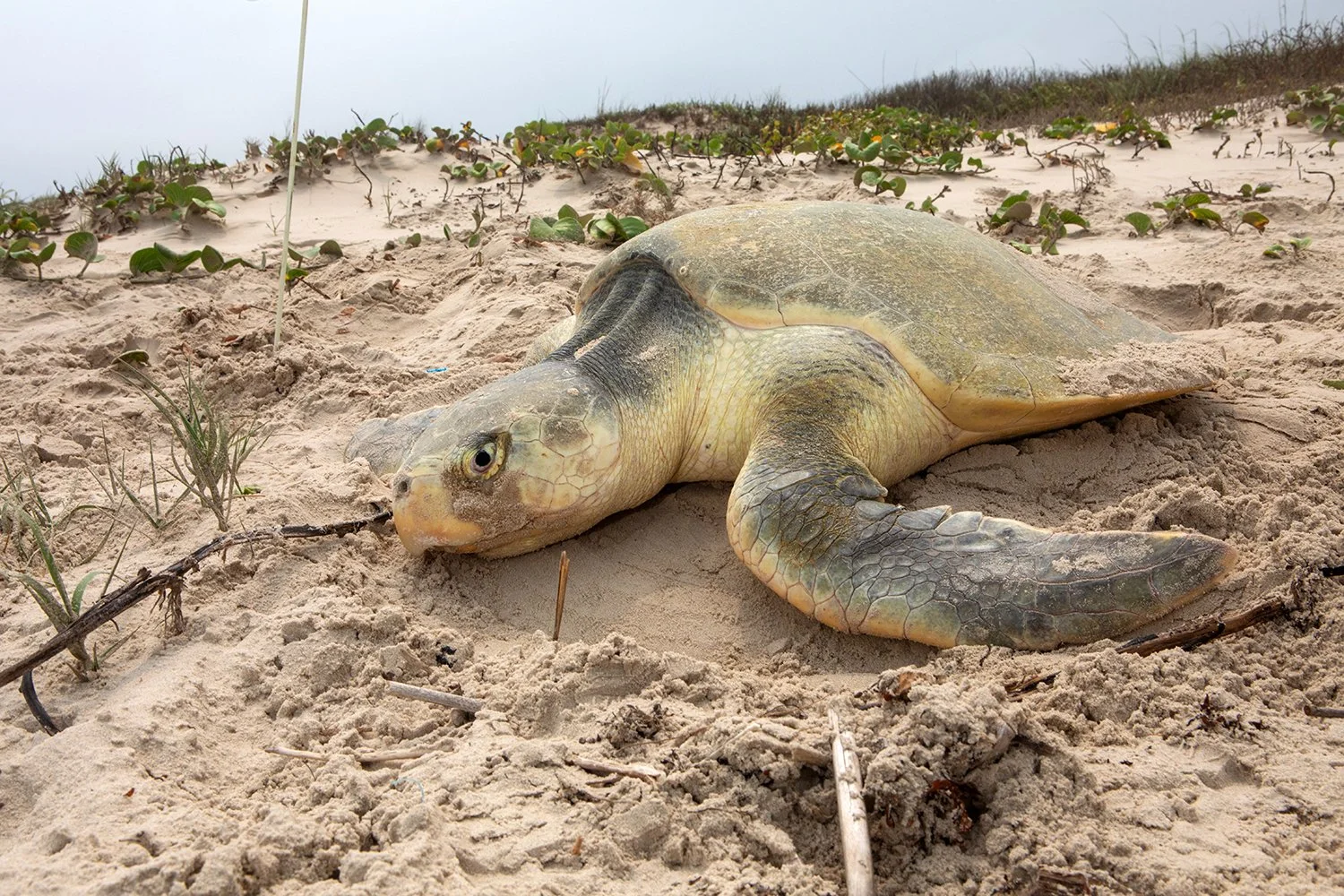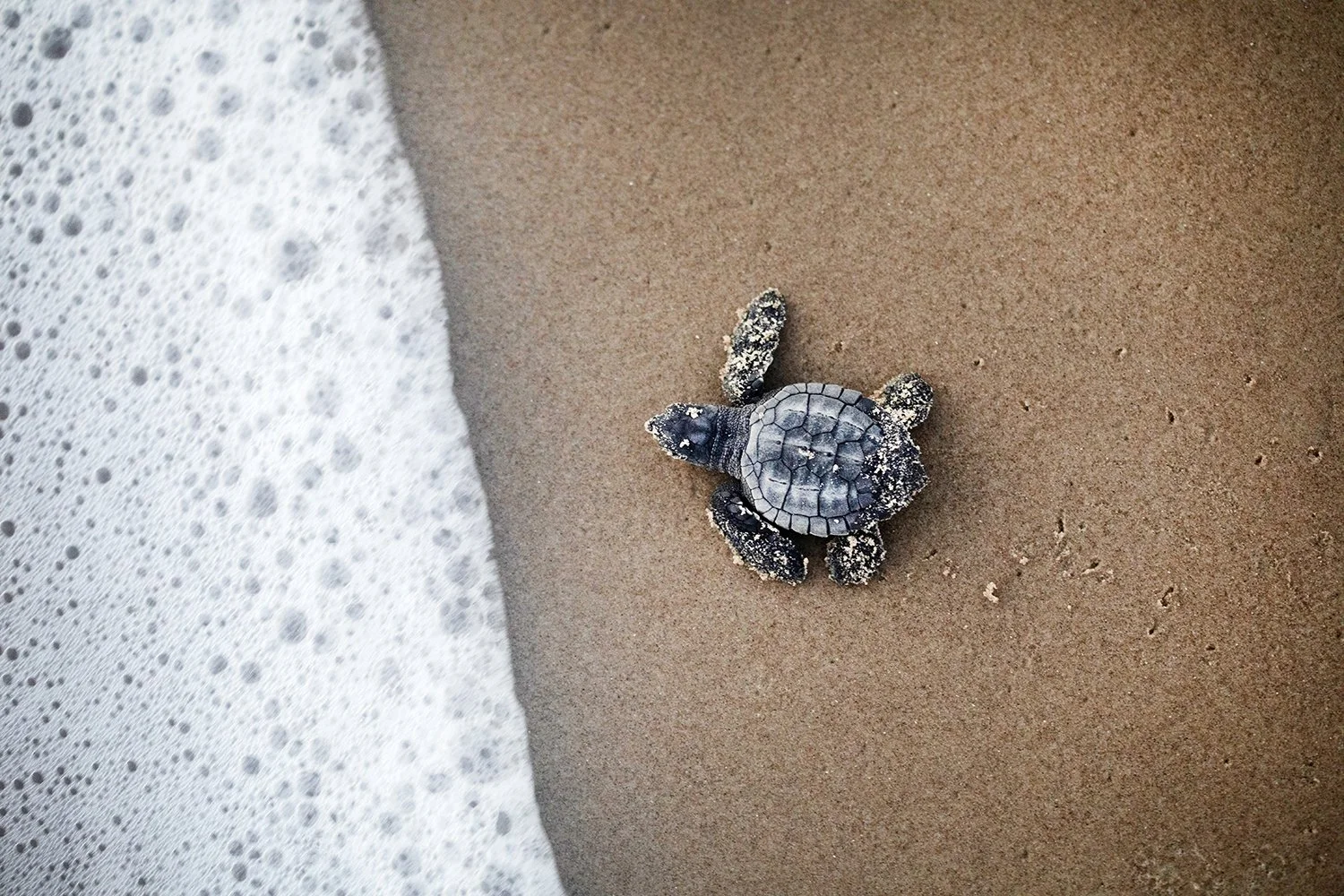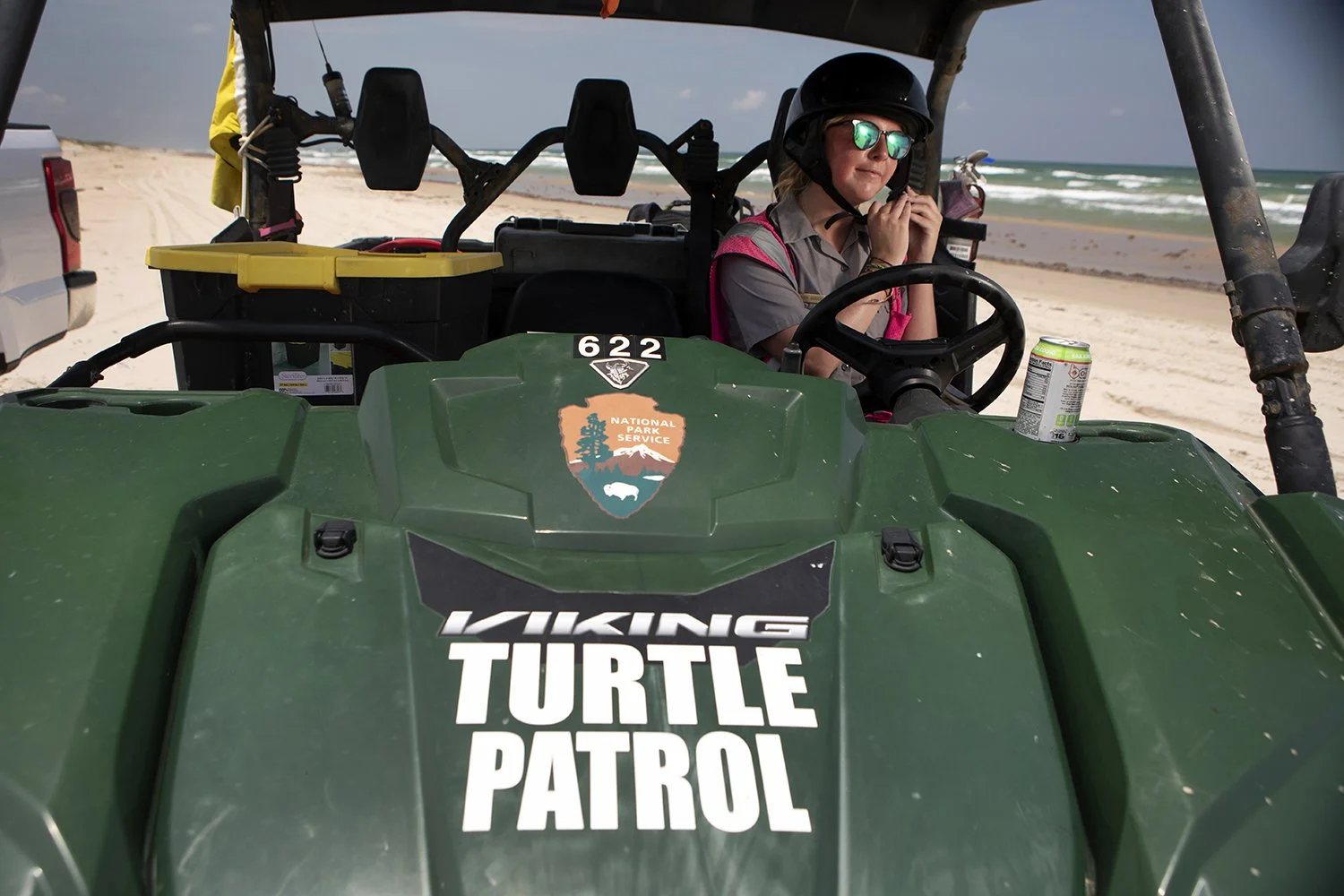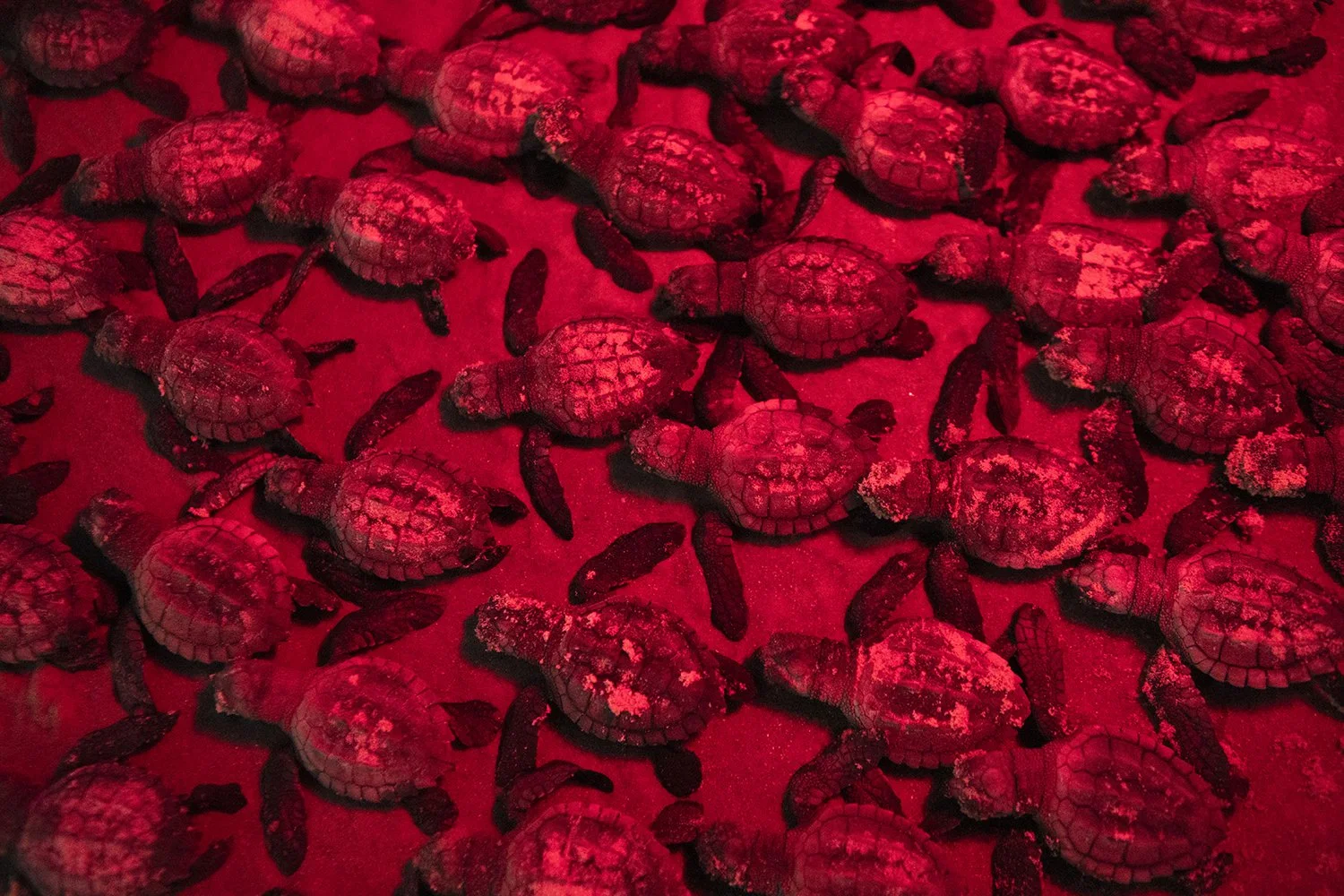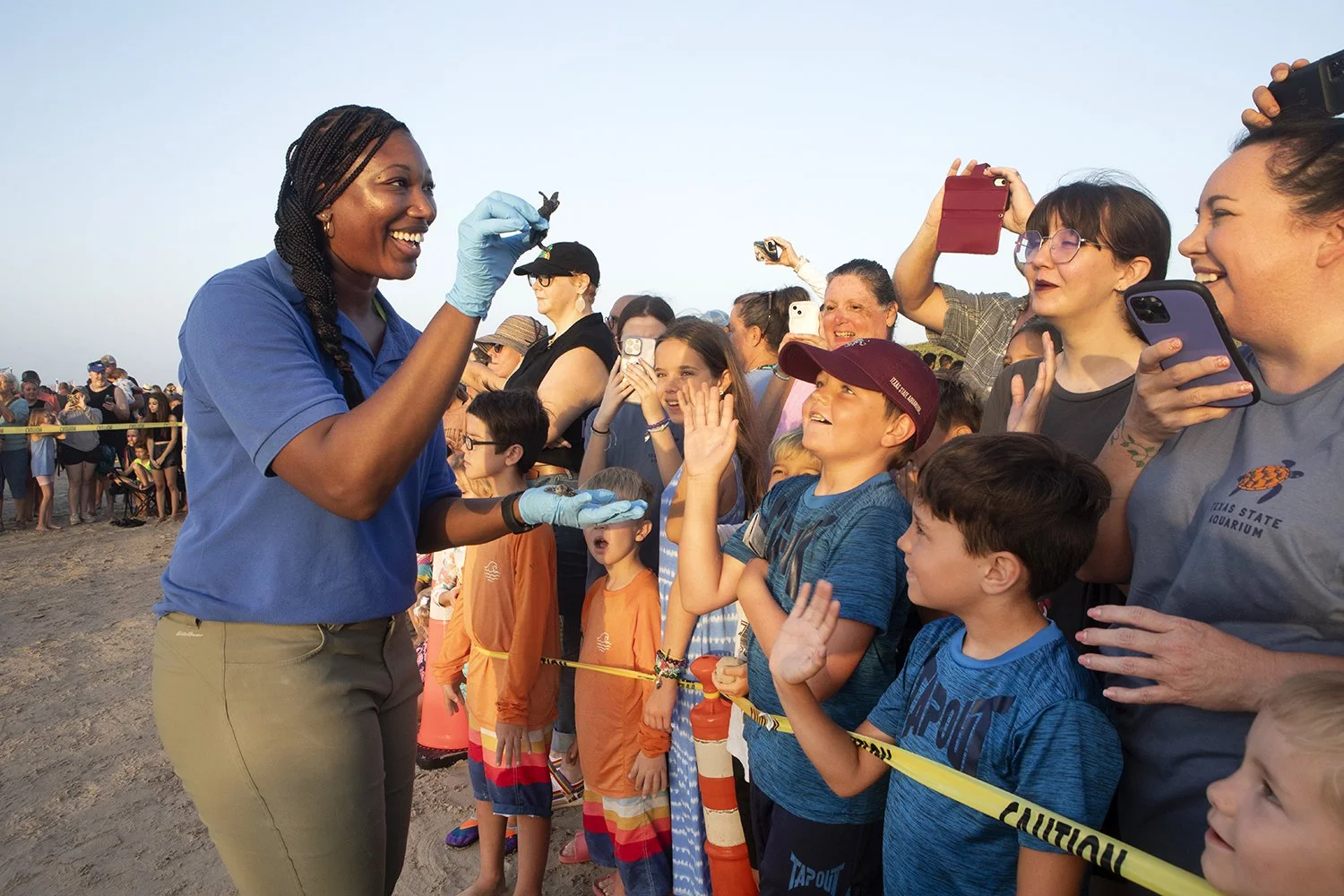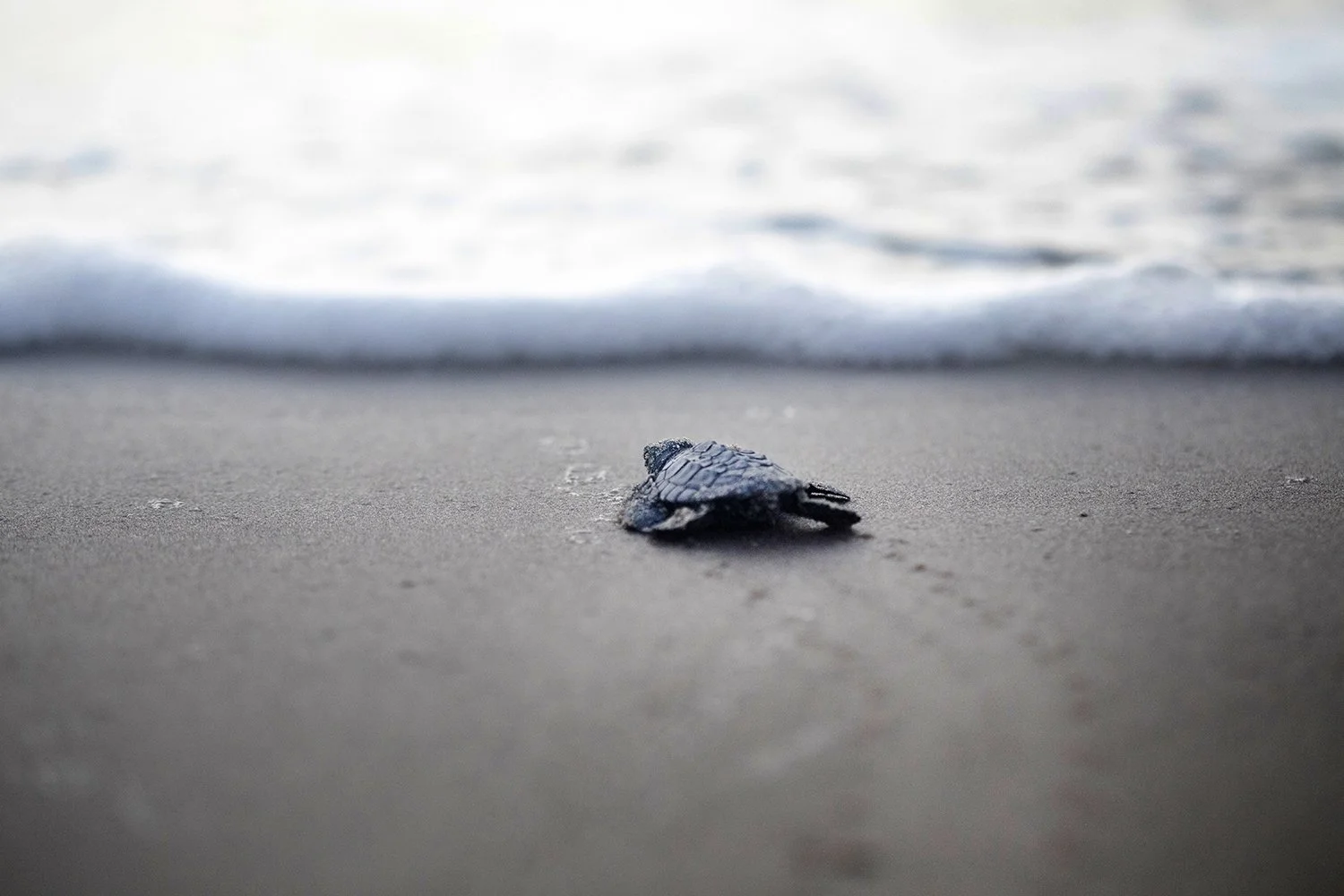BIOGRAPHIC / SOLUTIONS / 12.03.2024 / Story and photographs by Lauren Owens Lambert
After years of steady gains, a decades-long conservation program for the world’s most endangered turtle hits rough seas.
It’s a hot and windy May day on the Texas Coast, and Donna Shaver’s long ponytail, the color of sand, drips from underneath her ranger hat. She crouches down next to what looks like an imprint of angel wings in the sand. “This is where she covers them,” Shaver says.
Shaver, who is chief of sea turtle science and recovery for the National Park Service at Padre Island National Seashore, pokes the sand with a long stick, looking for the cavity of a Kemp’s ridley sea turtle nest. When she unearths the cache of ping-pong-ball-sized, cream-colored eggs, her eyes light up as if she is seeing a sea turtle nest for the very first time. In reality, she’s been studying turtles for more than 40 years. One by one, Shaver lifts the eggs of the world’s most endangered sea turtle from the nest, placing them carefully, without disturbing their original orientation, into a small cooler filled with sand. Then members of her team transport the eggs to the park’s incubation facility, where they will mature, hatch, and eventually take their first swim in the sea.
National Park Service biologist Donna Shaver, chief of the Division of Sea Turtle Science and Recovery at Padre Island National Seashore, gently pokes the sand to find a cavity harboring recently laid Kemp’s ridley eggs.
National Park Service biologist Donna Shaver places over 85 Kemp’s ridley eggs into a cooler to safely transport them to an incubation facility at Padre Island National Seashore.
The Kemp’s ridley (Lepidochelys kempii) has been hovering on the cusp of extinction for much of the past 50 years. Light gray-green, with a smooth, almost perfectly circular shell and a large, triangular head, it is the smallest species of sea turtle, topping out at two-and-a-half feet long and 70 to 100 pounds. Like all sea turtles, Kemp’s ridleys hatch in the sand and make the perilous journey across the beach and into the sea. The hatchlings then drift in the open ocean, clinging to floating sargassum and feeding on small organisms found in the seaweed. Scientists call this period of sea turtle development “the lost years,” because they know so little of what happens in this life stage. Some ridleys remain in the Gulf of Mexico, while currents sweep others around the Florida peninsula and into the Atlantic, where they can be found as far north as New England. After they reach a length of around eight inches, the turtles migrate closer to shore, feeding mainly on crabs and other crustaceans and continuing to grow until they are mature.
Scientists also know little about how long Kemp’s ridleys live, though estimates suggest a lifespan of at least 30 years. The males enter the water after hatching and never come ashore again. After the females reach maturity around age 13, they return to the beach where they were born every one to three years, laying and burying two to three clutches of approximately 100 eggs each between the months of April and July, then crawling back to sea.
Kemp’s ridley turtles are the only species of sea turtle that nest mostly during the day. They are also one of only two species that nest en masse (the other is the olive ridley), gathering offshore in large groups and clambering all at once onto the beach in what is called an arribada—Spanish for “arrival by sea.” It is in part because of this unusual behavior that the Kemp’s ridleys are so gravely endangered. With nearly the entire population nesting primarily in one spot—not in Texas but on one stretch of beach along Mexico’s Gulf coast—the species’ eggs quite literally lie in one basket. This is why Shaver has so carefully collected these soft, round eggs: she leads a remarkably successful program to safeguard and increase Kemp’s ridley populations. But after years of steady growth, the recovery has stalled. “We’re not going to meet the milestones that we’ve set,” Shaver says.
Now Shaver and her team are trying to understand why.
For years, the Kemp’s ridley posed a mystery to biologists; they called it “the riddle of the ridley.” The turtles could be found swimming in the waters of the Gulf of Mexico and western Atlantic, but no one had ever seen them nesting on land. Lacking evidence of reproduction, some scientists even speculated that the Kemp’s might be a “bastard turtle”—an infertile hybrid of other sea turtle species.
In the early 1960s, however, a University of Corpus Christi biologist named Henry Hildebrand learned of home video footage of turtles coming ashore on a stretch of beach just south of the U.S border near the remote Gulf Coast port of Rancho Nuevo, in the Mexican state of Tamaulipas. The video had been shot by a Mexican engineer named Andrés Herrera, who, while traveling in his prop plane on a summer day in 1947, spotted a beach covered in turtles, landed, and captured the event on film.
Hildebrand had been searching for the Kemp’s nesting ground for years, interviewing Mexican fisherman “at every palm-thatched local restaurant with a turtle carapace hanging on the wall,” as his colleague Pat Burchfield recalled. Hildebrand wrote to Herrera, who mailed him the film. He viewed it in astonishment: an estimated 10,000 turtles digging nests in the sand with their rear flippers while tens of thousands more hovered offshore like an invading armada. They buried their eggs in such large numbers that some even excavated the nest chambers of others as they made their own, and so many turtles surrounded the plane, Herrera later recalled, that he had to push the plane down the beach away from them to take off. No scientist had ever seen a mass turtle nesting event like this—a strategy known as predator swamping, with thousands of hatchlings overwhelming the threat of birds, coyotes, crabs, and fish.
Predation by humans, however, was another matter: Locals would swarm the beach—a human arribada of sorts—poaching millions of turtle eggs, which were prized as aphrodisiacs, and destroying close to 90 percent of the nests in the process, loading the eggs into trucks to sell at market. Shaver recalls Hildebrand as a “very unassuming man, with disheveled hair and wrinkly clothes.” But he was instrumental in recognizing the looming danger to the species. Ninety-five percent of Kemp’s turtles nested on one stretch of heavily poached beach.
Hildebrand worked with colleagues in both Mexico and Texas to appeal to Mexican authorities to enact conservation measures. In 1966, the Mexican government passed legislation protecting the beach at Rancho Nuevo and funding military teams to guard the eggs and females during nesting season. But populations continued to drop. By 1985, 40 years after the Herrera film showed tens of thousands of turtles climbing onto the beach, researchers found fewer than 250 nesting females in Rancho Nuevo. That year, those females dug just 700 or so nests.
This shocking decline spurred a larger international conservation effort, in the years that followed, to save the species from extinction. In 1970, the U.S. government had listed the turtle as endangered under the predecessor to the Endangered Species Act. The problem for the turtles was twofold: on land, the ridley’s lone primary nesting beach made eggs and hatchlings uniquely vulnerable to poaching, predation, and habitat degradation. At sea, large numbers of juvenile and adult turtles were being caught and killed in the nets of shrimping and other commercial fishing operations. Starting in 1978, both U.S. and Mexican environmental agencies implemented additional regulatory actions, such as expanding beach protections, enforcing anti-poaching measures, closing nearshore waters to shrimp trawling during crucial turtle migration times, and, in 1987, requiring shrimping and summer flounder vessels to use “turtle excluder devices”—metal grids that fit into the neck of trawl nets to allow turtles to escape.
In 1974, the National Park Service also proposed a unique program to establish an additional nesting site north of the border in Texas, to make the species less vulnerable to the risks of laying all their eggs in one place. “We wanted to get that secondary nesting colony in Texas in case of a catastrophic event in Mexico,” says Mary Kay Skoruppa, a biologist with the U.S. Fish and Wildlife Service in Texas. “Over 70 percent of all Kemp’s nest within an 18- or 20-mile strip of beach, which is crazy—talk about all your eggs in one basket. If something happened in that 20-mile stretch, that could be devastating to the species.”
The plan was both simple and elaborately ambitious: Collect freshly laid eggs from the beach in Rancho Nuevo and “translocate” them—move them very carefully, packed in Texas sand—to Padre Island National Seashore, the northern end of the turtle’s documented nesting range. “Nobody really knew how to get the turtles to imprint onto a different area,” says Shaver.
Kemp’s ridleys, like many turtles, imprint on the beaches where they are born, with females returning years later to nest in the same location.
For a decade, beginning in 1978, employees of the Park Service’s Division of Sea Turtle Science and Recovery collected and incubated 22,507 eggs—10 to 20 nests of 100 or so eggs each per year—of which more than 17,300 hatched. Once the eggs hatched, turtle technicians placed the hatchlings in the sand on Padre Island, letting them crawl into the surf to swim, briefly, in the Gulf of Mexico, in hopes the hatchlings would “imprint” on the coastline of their birth and return as adults to nest. The technicians would recapture the hatchlings in aquarium nets, then “headstart” them for a year in tanks at the National Marine Fisheries Service Laboratory in Galveston, Texas, feeding and caring for them until they had grown to eight or more inches long and were better able to evade predators. The teams placed tracking tags on the turtles’ flippers or shells and released them into the Gulf. Then the team waited to see whether the turtles would return to Padre Island to lay their eggs.
Shaver, who has an oval, open face lined from years tracking turtles in the sun, joined the effort in 1980. She arrived from her home in upstate New York as an intern, living in a trailer, walking the beaches looking for turtles and nests, and studying the Kemp’s ridley action plan that sat on her nightstand. She returned the following year after graduating college and spent most of the next 40 years working with the Park Service recovery program. When Shaver first arrived, Peter Pritchard, one of the world’s leading authorities on turtle conservation, told her that “he thought it might be too late to save the species,” she recalls. She spent the next decades making sure that it wasn’t. “The Kemp’s ridley is a magnificent species that I have dedicated my career to trying to help save.” Turtle recovery, she adds, “is my life.”
It still wasn’t clear, when Shaver arrived, that the translocation plan would work. In the beginning, “it was just looking for turtles that weren’t coming,” says Shaver. But on May 29, 1996—almost twenty years after the first eggs were moved to Texas—she got a call over the radio from one of her staff members, who had found a nesting turtle on the beach. Shaver raced to the site, arriving to find the turtle starting to cover her nest. “I quickly went to the turtle and as I brushed sand off her shell, I saw a large white spot on her back.” It was a “living tag”—a small, light-colored piece of tissue from the bottom of the turtle’s shell that park biologists had grafted onto the darker carapace to identify headstarted turtles. “I brushed it, looked at it, brushed it again. That was the first! I was jumping up and down, I was so excited.” It was a turtle that Shaver had helped to hatch ten years earlier, and it would be the first of dozens of females—laying an average of 135 nests per season—who have since returned. Today, more than half of Kemp’s ridleys in Texas nest at Padre Island National Seashore.
When she can during the April-to-June nesting season, Shaver joins her staff in patrolling the 70-mile Padre Island National Seashore, the longest undeveloped stretch of barrier island in the world. Volunteers and other staff members also drive across the sand in white trucks or small, green off-road vehicles with the words “Turtle Patrol” written on the hood and bright yellow turtle flags waving off the side. They search for evidence of nesting turtles: disturbance near dunes, “flipped up” vegetation or sand, and tracks leading to or from the ocean—an indication that a turtle came ashore to lay its eggs. The turtles are “masters” at covering their nests, says Shaver.
If the patrollers are lucky, they may run across turtles in the act of nesting, feeling the sand vibrate under their feet as the turtle thumps it down with her heavy carapace. After collecting biological data such as blood samples and shell measurements, Shaver and the park staff stand back to watch as an ancient species does what it’s meant to do. “It’s a hardwired behavior,” she says, “for a very primitive animal that’s been around for more than two million years, long before man showed up on Earth.”
When the team finds a nest, they count and excavate the eggs and place them in sand-filled coolers, transporting them to the Park’s incubation facility. There, egg coolers are stacked floor to ceiling on tall wooden shelves inside a dark, temperature-controlled room, to protect the eggs from predators like raccoons, skunks, badgers, coyotes, ghost crabs, and fire ants, along with the risk of flooding, erosion, or being run over by vehicles driving on the beach. For the next seven weeks—the eggs incubate for roughly 50 days—Shaver and the park staff visit several times each day to monitor the incubation progress, adjusting the temperature and humidity to maintain healthy development.
Padre Island Sea Turtle Science and Recovery Department staff and volunteers drive along the beach looking for nesting Kemp’s ridley sea turtles.
National Park Service biologists Madison Barber (left) and Mackenzie Merrill (right) from the Padre Island Division of Sea Turtle Science and Recovery record the carapace length of a nesting Kemp’s ridley.
Kemp’s ridley eggs in a cooler, en route to the Padre Island National Seashore hatching facility. Once they arrive, the eggs will be monitored around the clock by staff and volunteers to ensure they develop under ideal temperatures and humidity levels.
During the peak of nesting season, when there are more eggs than the staff can fully tend to, any eggs that they find on the beach’s remote southern end they bury in the sand inside an outdoor incubation corral, under a protected canopy. Because there is no electricity there, the corral requires a more hands-off approach, protecting the eggs from cars and predators but otherwise letting them incubate naturally. This strategy can be risky: In June 2024, for instance, Tropical Storm Alberto, the first named storm of that year’s hurricane season, hit during the height of nesting, battering delicate sites in Mexico and Texas. Eggs throughout Mexico and the Texas coast were destroyed, but thousands along the Padre Island National Seashore–including those in the corral—were evacuated to safety.
In the years after turtle protection measures were implemented, the number of nests in both Texas and Mexico increased at a steady rate of about 15 percent each year, growing from 702 nests, from fewer than 300 nesting females, in 1985 to more than 20,000 nests, representing approximately 8,000 nesting females, in 2009. Heartened by their progress, Shaver and her colleagues believed they could achieve the goal of delisting the species once it reached an average population of at least 40,000 nesting females per season worldwide, with a plan to downlist the species to “threatened” after teams documented at least 10,000 nesting females per season, among other criteria. Based on the ongoing recovery, researchers at the time predicted that downlisting might happen as soon as 2011.
In 2010, however, those numbers began to decline again. Nest numbers rose a bit in the following years, but then dropped again. They have fluctuated at reduced levels ever since.
Scientists don’t know exactly why the recovery stalled over the past 15 years. They suspect it is a combination of factors. The Deepwater Horizon oil spill, which began in April 2010, resulted in the release of more than one hundred million gallons of petroleum and more than one million gallons of oil dispersant into the Gulf of Mexico, polluting important Kemp’s ridley habitat. Other factors may include water quality, loss of nesting habitat from storm-fueled erosion, cold-stunning events, and overfishing of blue crab and other crustaceans, which are the turtles’ primary food sources.
Climate change and rising sand and ocean temperatures are also important factors. Many turtle eggs incubate best in sand temperatures below 35 degrees C (90 degrees F). Above that threshold, hatching success rates drop dramatically. Sand temperature also determines a turtle’s sex—warmer sand creates conditions in which more females hatch. “Hot chicks and cool dudes is a way we like to remember it,” says Natalie Hancock, a turtle biology technician at Padre Island National Seashore. Warming sand may change the sex ratio over time, producing fewer males and affecting survival rates in the long run.
Even as Mexican and U.S. authorities have managed to curb poaching and shrimping bycatch, and to diversify nesting sites, these other changes in the Gulf have damaged turtle habitat, possibly reducing the Gulf’s overall “carrying capacity” for the species—the number of turtles that the waters, in their current state, can support. Thane Wibbels, a biologist at the University of Alabama at Birmingham, put it bluntly in an interview for an oral history called the Texas Fauna Project. “Maybe 20,000 nests a year is as good as it’s going to get,” Wibbels said.
At the corral site near mile marker 45, halfway down the beach on Padre Island, a July evening breeze sweeps through the dunes. The sand shifts in the dark. Slowly, one by one at first, and then all together, Kemp’s ridley hatchlings push their small gray heads out of their nests, clambering on top of each other to look for the reflecting moonlight that will guide them to the water’s edge. The sand bubbles with hatchlings—biologists call this a “turtle boil.” Wearing glowing red headlamps (the turtles are sensitive to white light), the park staff work through the night, gathering and counting the hatchlings and placing them in a large container to bring them closer to the ocean.
-The Kemp’s ridley is still the world’s most vulnerable sea turtle. Given the population plateau and climate change risks, some scientists believe that they may need to do more to help future-proof the species, perhaps establishing more nesting sites farther north on the Gulf coast, or maybe even on the Atlantic coast. “I personally do not feel it prudent to wait and hope that Kemp’s ridley will resume its pre-2010 path toward recovery,” says Charles W. Caillouet, Jr., a retired biologist with the National Marine Fisheries Service, who argues that conservation officials must adapt a 20th-century program to 21st-century realities.
But in 2020, Park Service officials released a report arguing that sea turtle recovery costs at the seashore were unsustainable at nearly $2 million per year, and recommended reallocating funds to other projects, such as habitat restoration and beach cleanup. Since then, the agency has slashed public education efforts, cutting the number of public hatchling release events from around 25 a year down to five. Sea turtle researchers and advocates in Texas, worried about what further cutbacks could mean for the future of the Kemp’s ridley, have been pushing for the Park Service to retract the report and restore the program cuts.
At a public release in the summer of 2023, Shaver and her team carried thousands of young turtles to the beach. They had hatched just a few hours before, beaks piercing through the eggshells, tiny turtles emerging into the world. In the predawn hours, up to 2,000 visitors gathered nearby to watch as Shaver and her team ferried the hatchlings to the wet sand at the water’s edge. Shaver crouched on her knees as the sun started to rise, carefully lifting the hatchlings out of their box and laying them on the sand facing the vast sea, guarding them from crabs and gulls, herding stray hatchlings in the right direction. Unlike other turtle species, Kemp’s ridleys are slow to make their way into the water. It can take up to 45 minutes. They crawled by the dozens with a combination of cautiousness and curiosity, as they have for millions of years.
On average, Shaver and her team release around 17,000 Kemp’s ridley hatchlings into the Gulf of Mexico each year. “We’re preserving and protecting them for future generations,” she says. Conservation is a “long game,” she likes to say—an act of science and hope that spans generations of both turtles and humans. She watched the hatchlings move across the sand, her eyes slightly watery, like a mother with her child on graduation day, as the tiny turtles disappeared out to sea.



